“On the very day that George Mallory and Sandy Irvine disappeared on Everest, another party of British climbers slowly made their way to the summit of a quite different mountain and in very different circumstances. At 2,949 feet, Great Gable was not a serious or difficult climb, but it was said to be ‘the most completely beautiful of English mountains.’ It anchored the fells of Cumbria, and from its summit could be seen a dozen or more of the rounded hills and rocky crags of the Lake District, where so many English climbers had first discovered the freedom of open space and the feel of wind and rain and sleet on cold hands jammed into cracks of granite and slate.”
— Wade Davis, Into the Silence
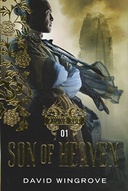 |
Son of Heaven (Chung Kuo Recast #1) by David Wingrove I must have been hungry for a good post-apocalyptic science fiction novel, because I flat devoured this one. Was it really that good? Actually, it was that good.The scene of the action shifts between two times set twenty years apart: post-collapse England, where survivors of the rioting and war that consumed the western world after the markets and all online systems failed live in small country villages, wary of roaming strangers and bandits; pre-collapse London, where Jake Reed works inside a visual and olfactory virtual datascape, playing the commodities market for his employer. Jake inhabits both times: he was there for the collapse, and he is in the country now, living a more basic life, trying to protect himself, his son, and a few close friends. And then the Chinese, who engineered the collapse in the first place, show up. The novel starts slowly but quickly builds momentum, and I found I could not stop reading for any but the most essential chores. The characters are well-drawn and the situations fraught with suspense and peril. Both pre-collapse England, including the cyberspace environment within which Jake works and the secure enclaves within which Jake and his friends live, safe from the hoards of UPs (unprotecteds) living outside the walls, and the post-collapse countryside and simple lives the survivors live, are well and meticulously detailed. Even the Chinese villains are more than one or two layers deep. Some big ideas are of course discussed, but never in a doctrinaire, Ayn-Randish way — I won’t compare David Wingrove’s writing to the masterful William Gibson’s, but it’s similar. Everything about this novel drew me in. Now the problem. I read this, the first of a two-volume set, as a Kindle book. Imagine my disappointment in discovering that the second book, Daylight on Iron Mountain, is unavailable in electronic form … I’m going to have to buy the paperback! |
 |
Into the Silence: the Great War, Mallory, and the Conquest of Everest by Wade Davis This is a huge work of non-fiction scholarship; a complete day by day, climb by climb recounting of the three separate Everest expeditions of 1921, 1922, and 1924, along with a detailed exploration of each climber’s background, education, prior climbing experience, and most importantly, experiences in the trenches and field hospitals of the Great War.What registered most with me were the values these men espoused: British rectitude, country above all, stiff upper lip, pip,pip, old chap … the values my own generation of Americans grew up with, minus the class system. Among those values, to be sure, is a streak of racism a mile wide. I was shocked to learn how the climbers treated the locals and even the vaunted Sherpas who made their climbs possible. They treated mules and dogs better than their “coolies.” After seven Sherpas plunged to their deaths on the North Col, the climbers sent this message back to base camp: “All whites safe.” The central character is George Mallory, of course, and the enduring mystery of the first Everest expeditions has always been how close to the summit he might have come. No one will ever know, but until someone invents the time machine, Wade Davis has narrowed it down as much as possible. The book suffers from the overwhelming amount of information Davis has collected. The best part of the book is Davis’ examination of WWI and the experiences of the generation of British men who lived through it. This part is both gripping and enraging (one wonders if it would be possible to get some of General Haig’s DNA in order to clone him and then whip him mercilessly for the remainder of his days). The second most gripping part of the book is the recounting of the first Everest expedition in 1921, which conveys the sheer scale of problems faced by the explorers. Later on, the examination of the debate over the use of oxygen (first used during the second expedition and only reluctantly again during the third) was fascinating, if only to help us realize how hidebound we can be in the face of new technology and good sense. But the sheer amount of information and detail, especially by the time Davis gets to the second and third expeditions, overwhelms, and the individual stories of endurance and heroism start to blend together. Mountaineers will relish the huge amount of information and detail contained here, and my sense of drowning in information is more my fault than Davis’. I borrowed the book from the library and needed to finish it by the due date. Better I should have bought a copy and read it episodically over a period of weeks. That is how this brilliant book should be read. |
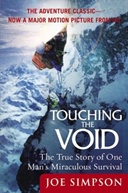 |
Touching the Void: the True Story of One Man’s Miraculous Survival by Joe Simpson A true survival story that captures and conveys the breathtakingly insane hang-it-all-out-there dangers of alpine climbing on unexplored ice- and snow-covered peaks. Joe Simpson includes a lot of technical language, but you quickly grasp what he’s talking about (and can refer to a glossary at the back of the book if you don’t, so no excuses). He does have a gift for making things understandable.Joe’s near-fatal fall, abandonment, epic crawl back to base camp, and ultimate survival make for a frightening story, one you’d barely credit if the survivor himself weren’t telling the story. I liked it that his climbing partner contributed to the book as well, describing his end of the experience. I admit being a little put off by the casual, almost cavalier way these two men (barely) attacked a previously unclimbed peak in an isolated area of the Andes … they would have been lucky to survive the experience even if Joe hadn’t fallen and broken his leg … and I wonder how many foolish young adventurers are inspired to take insane risks by emulating climbers like these. But it is not mine to judge. I’m glad they lived. I’m glad Joe survived to tell the tale. I couldn’t put it down. |
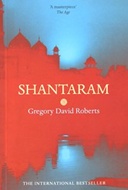 |
Shantaram by David Gregory Roberts A good friend loved Shantaram and loaned me her copy. Even though I wasn’t getting into it, I pressed on for almost 300 pages, about a third of the way through. It’s written well enough, but it demands a credulity I’m not willing to give it. I’m not going to hazard a rating on a book I put aside in mid-read, so no stars.Shantaram labels itself a novel, but Gregory David Roberts wants us to believe it’s a memoir. The author’s bio says he’s a former heroin addict who robbed people to support his habit and was imprisoned. He escaped from prison and lived as a fugitive in India. The book’s protagonist is a former heroin addict who robbed people to support his habit and was imprisoned. He escaped from prison and lived as a fugitive in India. We are clearly meant to think Shantaram is a slightly-fictionalized autobiography. I had a hard time swallowing the premise. In fact, by the time I decided to put Shantaram aside and move on to another book, I no longer believed Gregory David Roberts was ever an addict, a prisoner, or a fugitive. His tale is just too tall. In every chapter, he sets his protagonist Lin up for something that will make him look wise. Lin always makes the right move, always says the right thing. Lin invariably makes the right friends. When Lin comes to a fork in the road, he unerringly turns down the serendipitous path. Lin’s adventures are meant to wow us with the wisdom of the Indian people … cheap and easy wisdom at that, the sort of thing you’d get out of a TV movie about a plucky inner-city school teacher learning valuable life lessons from the ghetto kids in his classroom. People are good if you give them a chance. People may live in desperate poverty in slums, but they can still smile and work together. Bullies will back down if you let them know you’re not afraid of them. There’s a long tradition of Westerners pursuing Indian wisdom (and drugs, always drugs … Lin is no exception). But I’m not seeing any real wisdom here. Shantaram comes across as Slumdog Millionaire with a white hero, and that right there gives it a creepy imperialist overlay … as immersed as Lin becomes in the Bombay underworld, he’s still a white first-world foreigner, and the breaks that come his way come precisely because he is a white first-world foreigner. For all his talk of life-changing wisdom gained by living among poor humble Indians, had he been a poor humble Indian himself he wouldn’t have survived his first night on the mean streets of Bombay. |
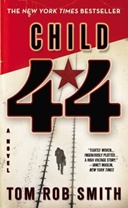 |
Child 44 by Tom Rob Smith A very readable mystery-thriller set in the Soviet Union at the end of the Stalin era, the heyday of purges and the gulag. The protagonist, Leo, an MGB officer, winds up on the receiving end (in Soviet Union, office politics eats you) and is demoted to a low-level militia job in a manufacturing town some distance from Moscow. While there he begins to chase down a serial killer who has been murdering children. Since officially there is no crime in the workers’ paradise, he only gets himself (and his wife, and his parents, and his associates) into deeper trouble. It’s hard not to compare Tom Rob Smith’s Leo with Martin Cruz Smith’s Arkady Renko. Leo is nowhere near as developed or believable as Arkady, and the situations in Tom Rob Smith’s story seem a little contrived compared to those Martin Cruz Smith’s novels … still, Child 44 is a gripping story, full of tense situations, suspense, and narrow escapes, and along the way one learns much about life in the old Soviet system, particularly how careful everyone had to be, and how dire were the consequences of standing out in any way whatsoever … in that way it’s almost a poor man’s Gulag Archipelago (no, just kidding … Solzhenitsyn actually had to live that shit). When I first started reading Child 44, I thought it was a young adult novel. Of course it’s not, but that reaction on my part probably says more about how Child 44 compares with the Arkady Renko novels than anything else I can say. If you have access to Child 44, read it. But if you have access to Martin Cruz Smith’s Arkady Renko novels, read them instead. |
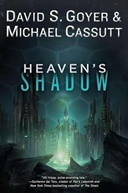 |
Heaven’s Shadow by David S. Goyer and Michael Cassutt Heaven’s Shadow is a science fiction “first contact” story. An object moves into the solar system and will pass close to earth, giving NASA and an international space exploration consortium a chance to land competing teams of astronauts on it during its closest approach. The near earth object turns out to be an interstellar ship, and the astronauts encounter some strange developments. The story is told from several points of view, bouncing between astronauts on the surface of the NEO, astronauts inside the NEO in contact with aliens, and mission control specialists on the ground in Houston. The controlling agencies on the ground do their best to keep the public in the dark about what’s happening, just as they would in real life, giving the story political realism and immediacy. The alien ship and the things that happen on board are fantastic yet thought provoking, and you want to keep reading to find out what happens next. The end is actually somewhat poignant. I miss good sci-fi. This was good sci-fi. |